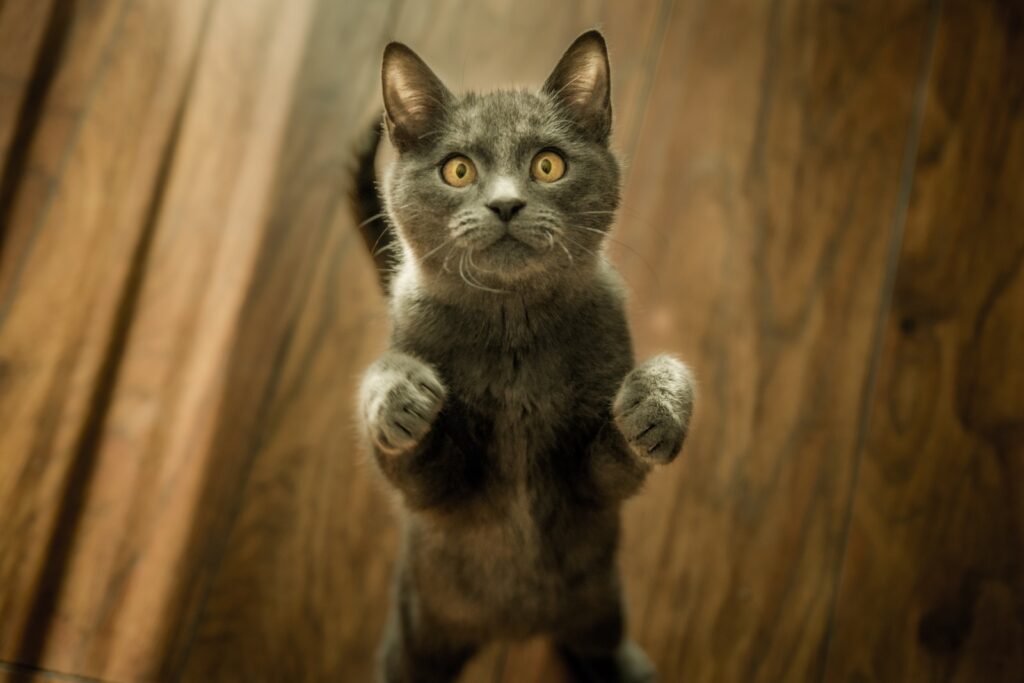Introduction: The Mystical World of Feline Communication
Ever observed your cat and thought: “What’s going on in that furry head?”
Feline communication is a complex dance of body movements and vocalizations.
Whether you’re a new cat parent or an old hand, understanding these signals
can deepen your bond.
A Quick Glance: The Eyes of Your Feline
Slow Blinking
This gesture is pure cat affection. It’s like they’re giving you a warm hug,
without the arms. When your cat blinks slowly at you, blink back! It’s a
bonding moment.
Dilated Pupils
Big, round eyes aren’t just for cuteness. They could indicate heightened
emotions. Is there a new toy? Or maybe a suspicious sound? Observing the
situation will give you the answer.
Narrow Pupils
These slits can be deceptive. It might mean your cat is basking in sunlight.
But, if the room’s well-lit and those pupils are thin? Your cat might be
feeling tense.
Staring
Cats are naturally curious creatures. A deep stare might just be their way of
examining something. But, be wary if it’s directed at another animal. It could
spell territory wars!
Speaking With The Tail: Feline Morse Code
Tail Upright and Quivering
An upright quivering tail is cat-speak for sheer joy. They might have spotted
you after a long day or found their favorite toy. Sometimes, though, it’s just
a quirky stretch after a nap.
Tail Flicking or Lashing
Cats lash their tails when bothered. It’s a clear “back off” sign. Did the
neighbor’s cat just strut by? Or maybe a new scent is bothering them? Keep an
eye out.
Tail Tucked Beneath
This is a protective stance. It means they’re trying to make themselves
smaller. It’s often seen in new environments or with unfamiliar faces around.
Fluffy Tail
Puffed up like a bottle brush? Your cat’s startled. It could be a sudden noise
or an unexpected guest. It’s their way of looking bigger to potential threats.
Whisker Wisdom: More Than Just Stylish Fur
Whiskers Forward
When those whiskers point forward, be on alert! Your cat has spotted something
intriguing. It’s their built-in radar system at work, detecting even the
slightest changes around them.
Whiskers Backward
If your cat pulls its whiskers back, tread carefully. It might be feeling
threatened. Whether it’s a sudden loud noise or an unfamiliar person, those
whiskers are signaling discomfort.
Whiskers Sideways
Spread out whiskers? It’s chill time! Your feline friend is at ease, probably
daydreaming about sunbeams or feather toys.
Whiskers Up and Forward
Your cat’s super engaged with something. Those forward-facing whiskers are
tuned to every vibration, gathering information about their surroundings or
that intriguing toy you’re waving.
Vocal Vibrations: When Meow Means More
Short Meow
It’s a simple greeting. Like a friendly “Hello!” or a curious “Who’s there?”
It’s the cat equivalent of a polite nod.
Prolonged Meow
This one’s a call for attention. Perhaps they’re hungry or just want some
playtime. It’s like them asking, “Are you listening?”
Low Pitched Meow
Uh-oh, someone’s grumpy. This meow’s a sign of mild annoyance or displeasure.
Maybe the toy’s not fun anymore, or they’re just not in the mood.
High Pitched Meow
Immediate attention needed! This might be a cry of pain or extreme distress.
Ensure they’re not hurt or in any kind of trouble.
Ears: The Feline Radar
Ears Forward
Cats are all ears when they’re intrigued. Those forward-facing ears mean
they’re listening keenly. It might be a bird chirping or the rustle of a treat
bag.
Ears Backward
Cautious or alarmed. When those ears go flat, it’s a sign. They could be
sensing danger or feeling threatened. It’s best to reassure them during these
moments.
Ears Sideways
If the ears are sideways, they’re uncertain. Your cat might be weighing its
options. Whether to chase the toy or take a nap? Life’s full of tough choices!
Ears Twitching
Twitching ears are a clear sign of annoyance. Maybe there’s a pesky fly
around, or perhaps they’re just tired of the same old toy. A change of scene
might help.
Conclusion: Becoming Fluent in Cat
Understanding cats is an art. Their subtle cues and behaviors offer a glimpse
into their world. As you spend more time observing, you’ll find yourself
getting adept at reading these signs. It’s a rewarding journey, strengthening
the bond with your feline companion. And always remember, a purr or a nuzzle
is worth a thousand words!





